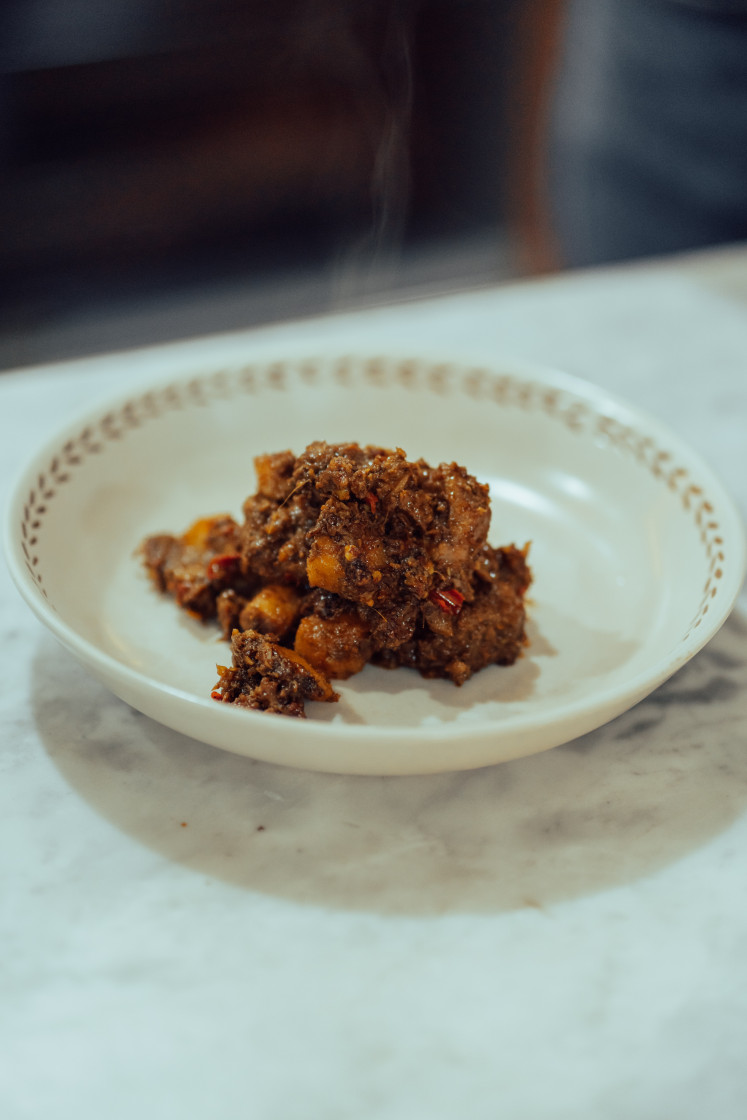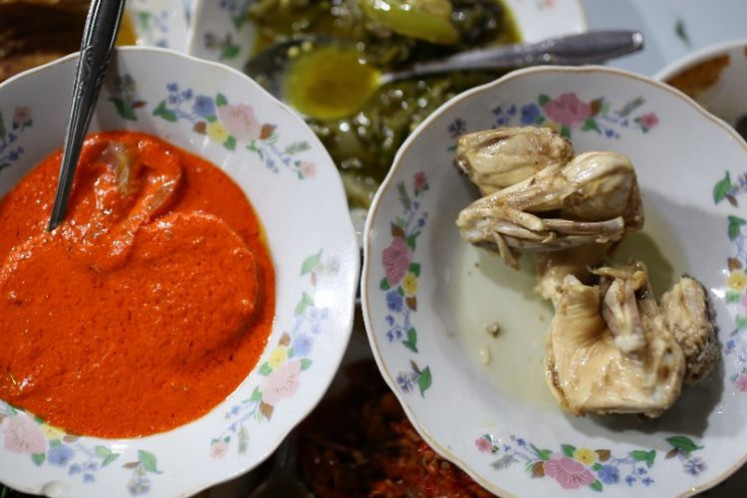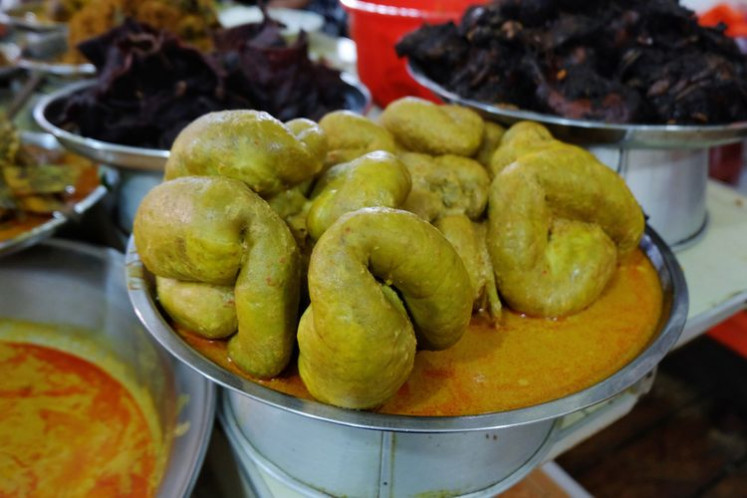Popular Reads
Top Results
Can't find what you're looking for?
View all search resultsPopular Reads
Top Results
Can't find what you're looking for?
View all search resultsTwenties: Essential Minangkabau cuisine
Arguably the most popular cuisine in Indonesia, Minang cuisine is a testament to the archipelago’s legacy of spice and diversity of dishes.
Change text size
Gift Premium Articles
to Anyone
T
wenties is a column where contributors offer their top 20 lists of anything and everything of interest, from food and history to pop culture and lifestyle.
It is a scenario familiar to all Indonesians: A dizzying array of plates assembled precariously atop one another, each carrying multi-colored dishes of strange yet fascinating origin. An ominous-looking spicy slab of meat here, an ocean of aromatic curry there and pools of fiery relish everywhere.
If you have been surrounded by this overwhelming sight and survived a better person, consider yourself initiated to the wonderful world of Minangkabau cuisine.
Born in the dramatic highlands and rugged coastlines of West Sumatra, Minang cuisine (or as it is more commonly known, Padang cuisine) is arguably the most popular food in Indonesia. Between its agreeably diverse repertoire and the Minang people’s own culture of merantau (migrating), its presence is felt on every corner of the archipelago -- with Singapore and Malaysia’s significant Minang emigres carving out a niche in our neighbor’s culinary legacy.
Travel even to the gates of hell, an old joke goes, and a Padang restaurant will be there.
And what sweet, glorious treats they are. Like most of its counterparts in Sumatra, Minang cuisine is heavily influenced by Middle Eastern and Indian cuisine -- with heavy curries, spicy relishes and grand feasts the order of the day. But it is also a reflection of local wisdom.
West Sumatra’s rugged terrain meant that almost all Minang dishes were fortified and preserved with copious amounts of spices to withstand long journeys. As such, it is a technique-driven cuisine, with its main ingredients often reflecting what is available in a certain region, but almost always in adherence to West Sumatra’s strict interpretation of Islam.
Through these 20 dishes -- many available in Minang restaurants in Jakarta -- let’s take a deep dive into one of the world’s best food cultures.
Beef rendang
Here is a simple equation for all to remember. Take a litany of spices, plop in local meat and vegetables and allow it to simmer. As it thickens, it becomes gulai -- a form of curry. As it reduces further and turns an agreeable shade of brown, it becomes kalio. Then when it has darkened, caramelized and its spice-blend almost returned to its primal state, it becomes rendang.
There is controversy over what meat can go into a rendang. Most famously, it is a fantastic way of rendering down tougher cuts of beef into outstandingly savory morsels of happiness. Water buffalo, mutton or offal are used, especially in specialty restaurants. Chicken and duck require a slight tweaking in the recipe, but are common. Seafood, such as anchovies and squid, are also used.
What is not controversial is how delicious it is. In 2011, an online reader’s poll of 35,000 people chose rendang as the number one dish on CNN International’s Reader’s picks list.
Dendeng batokok
For lovers of spice and heat, dendeng batokok is a savory morsel of delight that is not-to-be-missed. Meat, often from cattle and occasionally from water buffalo, is pounded into oblivion until it is fall-apart tender. Then it is stewed, fried (some skip this step) and served with a tangy, refreshing relish made of green chilies. With a plate of steaming white rice, it is a dish that is hard to beat.
Asam padeh
Perhaps the most intensely Sumatran of these dishes, asam padeh is a spicy, tangy stew that primarily features fish or other seafood. Laden with tamarind and chili, it is similar to other stews in the island’s north and south, but it is more velvety, savory and intense in flavor. Mackerel is a famous protein of choice, though squid, tuna and other riches of the sea are also common.
Itiak lado mudo
Grilled, stewed down and served with a plate of rice and (bewilderingly) slices of cucumber, itiak lado mudo is one of those unmissable dishes. A specialty of Ngarai Sianok, deep in the highlands of West Sumatra, it consists of flash-grilled duck that is then lathered in a luxurious bath of spices and green chillies, before it is finished in a thick stew. A staple of harvest ceremonies in one of the island’s most lush regions, it is a dish laden with tradition and history.
Specialty: Native to the Ngarai Sianok region, itiak lado mudo is a fiery duck stew laden with green chilies. (Wikimedia Commons/Tika) (Wikimedia Commons/Tika)Ampiang dadiah
Famously featured in Gordon Ramsay’s television program, Uncharted, ampiang dadiah is a yogurt-like dish made by fermenting water buffalo milk inside bamboo stems. Within two to three days, the liquid is coagulated, and its gloopy results ripe for serving.
Breakfast of champions: Pictured is a serving of ampiang dadiah, local yogurt with shaved ice, sticky rice cakes, palm sugar and ice. (Wikimedia Commons/Adhmi) (Wikimedia Commons/Adhmi)Some more hardy outdoorsmen will take this tangy, cheesy concoction and use it to temper (and enhance) sambals and spices. But more commonly, it is served as a dessert with pounded sticky rice, a sweet sauce of palm sugar and crushed ice.
Ayam pop
With its pale, sober appearance, one might be forgiven for mistaking ayam pop with bland boiled chicken. But nothing could be further from the truth. Slabs of chicken are lathered and boiled in spices and coconut water, before being flash fried to crisp up the skin -- while the inside remains juicy and its appearance remains pale. Served with a mildly spicy tomato-based sambal, it is one of the archipelago’s great chicken dishes.
Simplicity: Boiled in spices then flash fried, ayam pop is a top-tier chicken dish. (Kompas.com/Andreas Lukas Altobeli) (Kompas.com/Andreas Lukas Altobeli)Bubur kampiun
As the tale goes, sometime in the 1960s the government held a culinary competition deep in the highlands of Bukittinggi, West Sumatra. A veteran sweet porridge pedlar named Nenek Amai turned up totally unprepared, and simply served a collection of her leftover porridges in a bowl. Of course, she won the competition.
Literally meaning “the porridge of champions”, bubur kampiun is a mix of porridges made of sticky rice, black sticky rice, banana, mung beans and basically anything you can think of. The resulting overwhelming, yet sometimes messy concoction, is a popular breakfast meal.
Usus tambusu
Is it a sausage dish? Is it an egg dish? Is it an offal dish? The answer is that it is all three -- and none of the above. Usus tambusu is a curry with a peculiar choice of protein -- segments of cow’s intestines, filled with a mixture of eggs and crumbled tofu, which are then stewed until mind-bogglingly tender in a complex yet subtle spice broth.
A must-try: Tambusu is a dish of intestines stuffed with a mixture of eggs, tofu and spices. Not-to-be-missed. (Shutterstock/Fidia Helanti) (Shutterstock/Fidia Helanti)No, it is not good for your health. Yes, you should definitely try it.
Sate padang
Every civilization everywhere has figured out at some point that when meat is skewered, lathered with spices and grilled over hot coals, good things will happen. And the Minang are no different.
Their iteration of satay, though, is different from in other parts of the country. For one, it is primarily beef-driven -- expect offals such as beef heart, tongue and even liver to turn up between thinly-sliced meat. Then there is the small matter of its sauce. Though it contains peanuts, it is different from the savory-sweet peanut sauce beloved in Javanese satays. Instead it is thicker, smoother in texture and noticeably spicier.
Gulai paku
A welcome respite for all vegetarians reading this list. Gulai paku hails from the seaside town of Pariaman, and is a hearty curry starring the pakis (fern) leaves ubiquitous in the region. Suffused with a complex spice blend of chillies, galangal, turmeric and many others, it is most commonly served with ketupat (rice cakes) and is a popular holiday dish.
Teh talua
This drink is available in tea-houses and warungs all across the province, fueling all-night discussions and important fireside chats. Teh talua began with a curious mixture of egg yolks which are whisked into a carbonara-like slurry with sugar (and sometimes spices such as nutmeg or cinnamon). Thick, piping-hot tea is then poured over the substance, before it is vigorously stirred and served with a wedge of lime.
Gulai banak
This is a dish that is guaranteed to excite passions. Gulai banak literally means brain curry, and -- yes – it is made with cow brains, ever-so-lovingly stewed in a beautifully savory broth of spices and coconut milk. Perhaps due to the brain’s tender texture and its distinctive sharp tang, the flavor of the curry is not as strong as others in the Minang repertoire -- so there is no hiding place from the mass of organs that is confronting you on the dining table.
Soto padang
As Minang dishes go, this one is relatively more composed and mild-mannered. West Sumatra’s iteration of the nationally famous soto is a hearty soup of clear beef broth, spooned over a mix of beef, vermicelli noodles and a slab of potato pancake. Topped with pink krupuk crackers and a wedge of lime, it is a filling, delicious mid-day meal.
Gulai gajeboh
One of the most infamous and popular dishes in West Sumatra, locals dubbed gajeboh (food from the heavens) -- perhaps because its uncompromising punch of fat can drag unhealthy foodies more quickly into the afterlife.
Made from meat from the cow’s shoulders -- a prized cut in West Sumatran cuisine -- gajeboh is a combination of flesh and tender fat. Apocryphally, the ideal ratio of fat to meat is three to one, though some would consider an all-fat gajeboh to be superior. The deadly slab is stewed until tender in asam padeh broth, its tangy spice counterbalancing the fattiness of the meat.
You only live once. Go for it.
Kalio
Literally half-done rendang, it is derived from the same spice blend and is cooked down in the same way. The only difference being that in kalio, the cooking process ends when the mixture is still thick and slightly soupy, instead of reducing and toasting it like in rendang.
This means that common rendang proteins such as beef and chicken are more tender and less intense, making a good introduction for newcomers to Minang cuisine. But it also means other proteins that would have otherwise fallen apart in long cooking can be used: Think potatoes, liver and even spleen.
Pangek masin
A specialty of Padang, pangek masin is a subtle and more forgiving curry than many others on this list. Its broth is augmented with spices such as ginger, shallots and turmeric, before copious amounts of coconut milk are poured in to create an aromatic curry. Slices of belimbing wuluh (a small, fragrant and acidic cousin to the starfruit) are sometimes added to add another dimension to the dish.
Mackerel is often the protein of choice -- aficionados will go to the ends of the earth to point out that its head is the perfect part for this dish.
Palai bada
A pocketful of happiness. Palai bada is a dish of whitebait, anchovies or any small local fish bathed in spices, grated coconut and chilies, then wrapped in banana leaves. The package is then grilled over hot coals, and often served with sago or white rice. Smokey, spicy and surprisingly sweet, palai bada is a great afternoon side dish for a meal overlooking the West Sumatran scenery.
Katan durian
We are well aware that durian is a fruit guaranteed to spark intense debates. Its supporters will extol it as a creamy, sweet, custardy delight and most assuredly the king of fruits. Its detractors will dismiss it as a gloopy mess with a pungent aroma that is enough to make it banned in most public places, even in Southeast Asia.
The debate ends in West Sumatra, though, as it is most definitely a durian country. When the divisive fruit is in season, expect to see it served with a side of sweet sticky rice and topped with grated coconut. Locals flock to durian stalls, and this is their way of enjoying it.
Langkitang
A specialty food if ever there was one, langkitang is something found all over the province, but best eaten on the shores of lake Maninjau, a popular tourist destination. The star of the show is the eponymous langkitang -- a type of freshwater snail found all over the lake -- which is cooked down in a hearty curry that is left to reduce until it forms a thick mass of spices and good eating. A cut is made on the snail’s brittle shell, from which you are meant to suck the delicious flesh within.
Cancang karani
West Sumatra’s rendition on meatballs is a fine-tuned dish. Made with beef and traditionally composed without eggs or flour as its binder, it is difficult to cook without it falling apart. It is gently and delicately stewed in a subtle coconut milk base, then topped with parboiled potatoes. Rarely found in restaurants, cancang karani is more commonly found in weddings and ceremonies. So, upon seeing a pot of this magical dish, there is only one thing to do: Grab a bowl and seize the day.
















